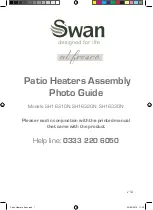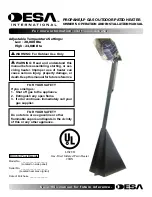
17
13.2 - FIRE SURROUND REQUIREMENTS (See diagram in Section 13.1)
General
If a fire surround is being used we supply a Cable Fixing System as Drill Fixing may result in cracking of the back panel, which may not show
until the fire has got hot and then cooled down over a number of operations.
If the fire is being fitted against a Non Combustible Wall then the Fires Fixing Brackets with Drill/ Rawlplug Fixing Must be used and Not the
Cable Fixing System. Always Ensure The Fixing Points are Robust and Secure.
See the Wall Fixing and Cable Fixing Diagrams on Page 20.
a.
If the Fire is to be fitted with a purpose made Fire Surround it
MUST
have a temperature rating of 150
º
C.
Where a natural material Fire Surround is to be used, due to the possibility of cracking, we recommend that the Back Panel of the
Surround is made of 3 pieces with a top and sides. Some back panel materials claiming a 150
º
C rating may still not withstand the
temperature variations created by this high efficient output fire and again we would recommend a 3 piece back panel.
b.
The Fire requires a non-combustible hearth of at least 12mm thick if the hearth as an upstand it must not be higher than 15mm
otherwise the Controls Door will be able to be opened.
c.
The surface of the hearth must stand at least 50mm above the floor level.
d.
The hearth must project at least 300mm in front of the fireplace opening and 150mm either side (700mm minimum hearth width).
e.
The base of the Hearth level and square to the face of the Firesurround Back Panel.
f.
There must be a minimum flat surface around the Fireplace Opening allowing 630mm high by 635mm wide.
g.
The Fire Surround/Back Panel must be fully sealed to the Fireplace.
h.
The Fireplace Opening should have provision for a gas supply through the rear, see Section 10 Gas Supply.
i. .
Dependant on the Control specified the fire may be fitted with Electronic Equipment, which is sensitive to dampness and high humidity so
it is
very important
that any rendering/building work is allowed to thoroughly dry out before Installation.
! IMPORTANT NOTE !
Dry lined walls - ensure that any air gaps between the back of the plasterboard and wall are sealed
around the builders opening or fireplace as this can cause overheating of the wall, wall staining and re-
duce the heat output of the fire.
! IMPORTANT NOTE !
Ensure the VCL (vapour Control Layer) is resealed as it will be affected by the Installation.
13.3 - FALSE CHIMNEY BREAST APPLICATION
a.
If it is decided to use a false Chimney Breast to accommodate the fire then the details for materials, sizes, clearances are as detailed
above and the diagrams on the previous page.
b.
The void around the flue must not be packed with insulation and we also recommend that ventilation openings/grilles are added to
ventilate the void of the False Chimney Breast at high and low Level.
This will allow the cooler room air to circulate around the void of the Chimney Breast, which will reduce temperatures and assist with wall
coverings applied to the Chimney Breast.
13.4 - CLEARANCES TO COMBUSTIBLE MATERIALS AND SHELVES
a.
A
non combustible
shelf can be fitted above the fire and should be positioned at least 95mm above the builders opening.
We recommend the depth of the shelf should be a maximum of 75mm as
anything deeper will reduce convection air and the efficiency of the fire.
For deeper non-combustible shelves they must be raised a further 25mm for
every extra 25mm of depth.
b.
A 150mm
combustible
shelf can be fitted above the fire but must be positioned
at least 250mm above the builders opening 750mm minimum from the hearth.
For deeper combustible shelves they must be raised a further 25mm for every
extra 25mm of depth.
c.
Any combustible sidewall must be 700mm central about the flue, however with
a combustible fire surround with side walls deeper than 150mm this distance
must be increased by 25mm for every extra 25mm of depth.
d.
With all heating appliances, soft furnishings, decorations and wall coverings may
discolour or scorch if placed too close.
e.
No combustible material, e.g. curtains must be closer than 500mm to the fire.
f.
Any combustible wall claddings (wall paper) must be cut back centrally about
the flue to 620mm high and 560mm wide.
g.
Due to the heat output of the Fenton Balanced Flue it is
not recommended
to
use blown vinyl wall covering around the fire.
13.5 - CUTTING THE HOLE FOR THE FLUE
With an installation into an existing property, (as apposed to a new build), where the internal wall structure will need to be checked
for the positions of Combustible Materials by removing part of the internal wall we recommend that the hole position is determined
from inside, the following Notes will assist:
a.
With a Timber Frame House it is recommended to firstly determine the best position for the fire/flue ideally between supporti ng
studs and check for any services like electrical wiring or plumbing.
b.
The flue is 150mm in diameter, and a hole is required providing sufficient clearance, we recommend 160mm diameter minimum.
c.
We recommend that you determine the hole position by pilot drilling from the inside before removing any of the internal wall.
With hole position now know on the outside wall you can cut the hole knowing its in the correct position.
a.
If cutting the hole with a core drill as the outside wall is brick work ensure your cutting into solid material as it may wander.
b.
Partially drill the hole and then check the fit of the flue before finishing,( a Wall Plate is provided for the outside).
c.
For cutting out the hole with a chisel, first firstly follow step
‘c’
to find a centre then mark out the hole and then use small holes around the
hole before cutting out with the chisel and making good the hole,( a Wall Plate is provided for the outside).
d.
Ensure the hole is horizontal, round and straight.
e.
Refer to Section 13.1 for requirements for the internal wall structure and protections required for combustible materials.
f.
Any internal plaster board typical to a dry lined property should be cut back 25mm around the flue, e. g. 210mm diameter.
NOW PROCEED TO SECTION 14 - PREPARING THE FIRE & FLUE.
Dry Lined Internal
Walls with Cavity
Cavity Sealed
Off 100mm
away from Flue
Combustible Shelf
Minimum Height
Non Combustible
Minimum Height
Plaster Board
Cut Back 25mm
Around Flue
















































